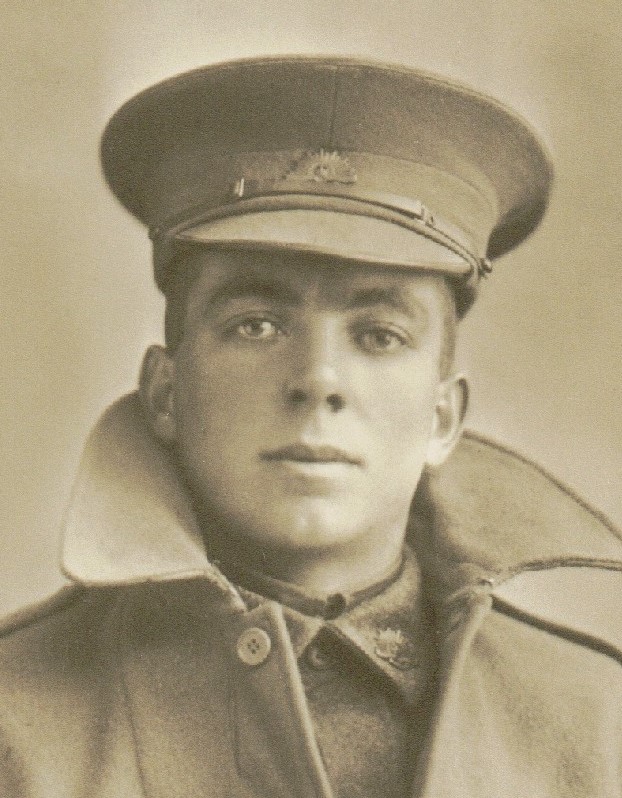Andrew Shillabeer
Name: Andrew William Shillabeer

Rank: Private
Service Number: 6821
Units: 10th Battalion 1st AIF
Personal Life: Andrew William Shillabeer was born on 6th February 1897, at “Attyford Farm” at One Tree Hill. His parents were Sam Millar Shillabeer and Sarah Isobella, nee Stewart, and he was the 3rd of 12 children. His father was my great grandfather’s cousin making him my 2nd cousin twice removed.
He attended the Precolumb School at One Tree Hill, a small school on a parcel of land that was part of a farm known by the same name and donated by the farmer John Sampson, so that his and other local children could get an education. After finishing school, he worked as a labourer, although his mother described his calling as “Home Duties” on his Roll of Honour circular that she submitted after the war.
Enlistment Details: Andrew enlisted on the 16th of June 1916 at the age of 19 years and 4 months. He was 5 foot 10 inches tall, (178cm), which was above average for the time and weighed 154 pounds, (71kgs). He had a medium complexion with brown eyes and dark hair and was a member of the Methodist Church. He was assigned to the 22nd reinforcement of the 10th Battalion.
Service: After enlisting Andrew became ill with measles and spent from the 10th of July until the 15th of September in hospital. He then went into camp as a member of the 22nd Reinforcement of the 10th Battalion on the 3rd of October 1916 at Mitcham where he trained until he boarded the “Afric” on the 7th of November and left Adelaide. While at sea he spent time in the ship’s hospital suffering from mumps. He arrived in Plymouth in England on the 9th of January 1917. From here he went to camp at Durrington in the Salisbury area where he continued to train. On the 26th of January he went to Fargo Hospital with influenza and bronchitis. He took some to recover and it was the 25th of April before he returned to camp for training.
On the 29th of May Andrew left camp and was sent to France. He arrived at the Australian Divisional Base Depot at Le Havre on the 30th of May and remained there until the 16th of June when he marched out to join his unit. He was taken on strength of the 10th Battalion on the 17th of June 1917.
The 10th Battalion was at this time based at Ribemont undertaking training and recuperation. On the 24th of June they marched to Mailly Maillet and were billeted there for the remainder of the month and for the first week of July. Here they undertook further training in attacking outposts and trenches. The battalion then returned to Ribemont and continued to train at a variety of places throughout July, August and the first part of September.
On the 19th of September the battalion moved forward to the frontlines near Ieper where it was involved in the battle of Menin Road on the 20th to 22nd. They fought their way through Glencorse Wood and into the edge of Polygon Wood. This was Andrew’s first taste of battle and the battalion suffered 214 casualties during these 3 days.
The battalion then retired to Steenvoorde before returning to support lines just north of Polygon Wood on the 1st of October. The battalion spent the first week of October moving between support and reserve trenches and on the 4th of October was in support of the 3rd Battalion during the Battle of Broodseinde Ridge. It took over the front line in front of Celtic Wood from the 12th Battalion on the 7th of October. On the morning of the 9th of October about 88 officers and men, mainly from the 10th Battalion conducted a raid on Celtic Wood with the intention of destroying dugouts and capturing prisoners for identification purposes. Due to weak artillery support the raid was not successful and a large number of those involved were killed or wounded. It is believed that Andrew was a member of this raid and that he was killed in action at some time during it along with 28 others on the raid. 3 other soldiers died of their wounds received during the raid. His body was never recovered, and his name is on the Menin Gate Memorial in Ieper. He was 20 years old at the time of his death. In an obituary published shortly after, he was described as being “much esteemed for his gentlemanly and kindly disposition”. In 1918 his mother requested the army place the words “To live in the hearts we loved is not to die” on his headstone, but unfortunately Andrew was never to have one.
Andrew’s death date is recorded as being the 8th October, as there was an administrative error that lead to his, and that of a number of others killed during the raid, being recorded incorrectly.